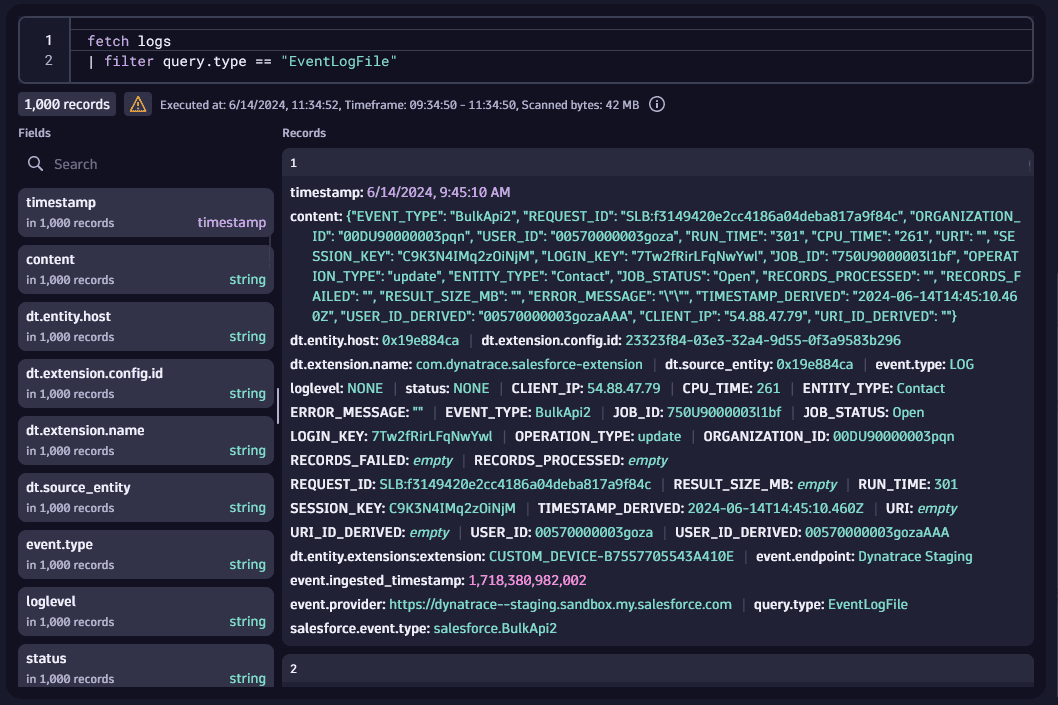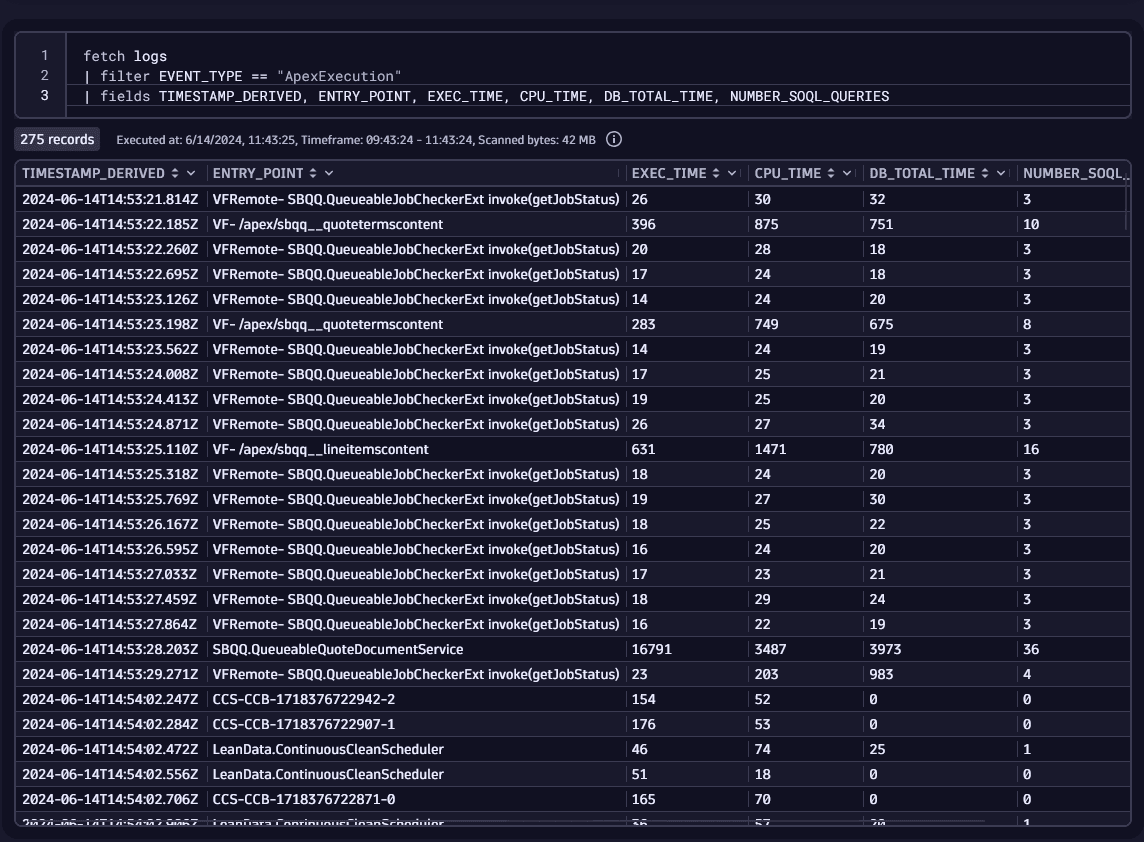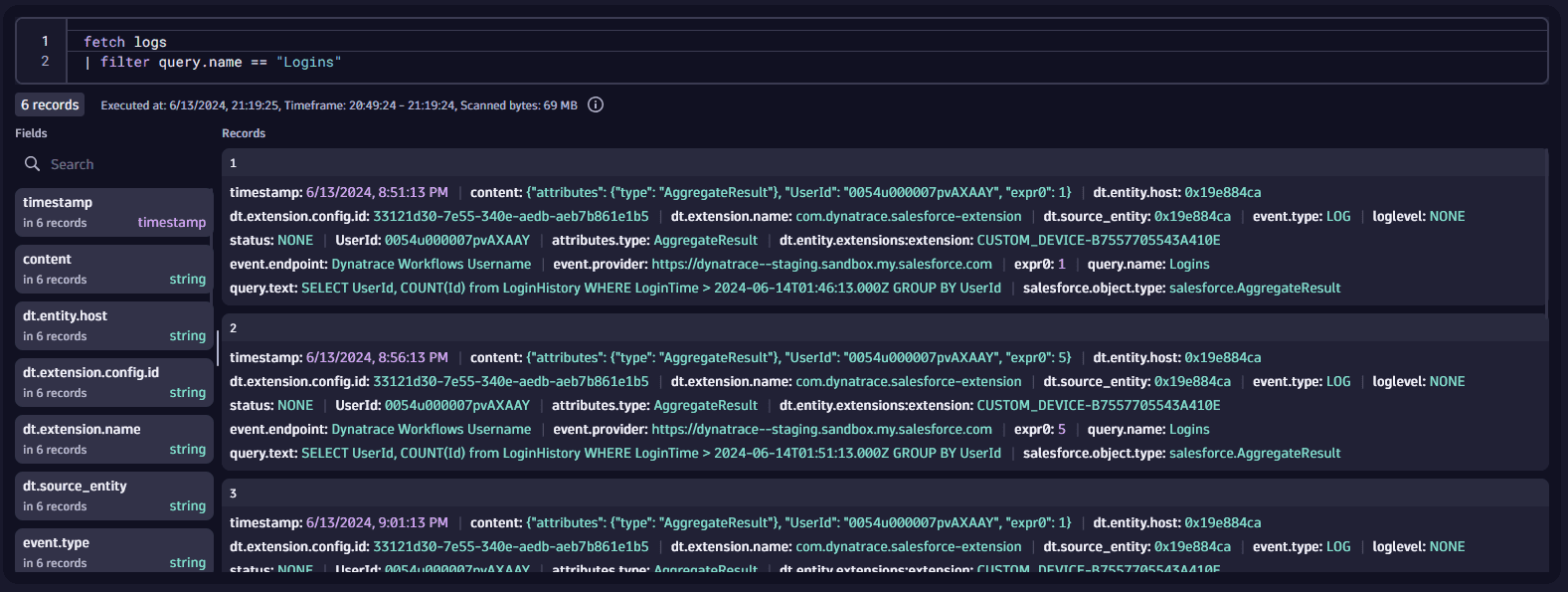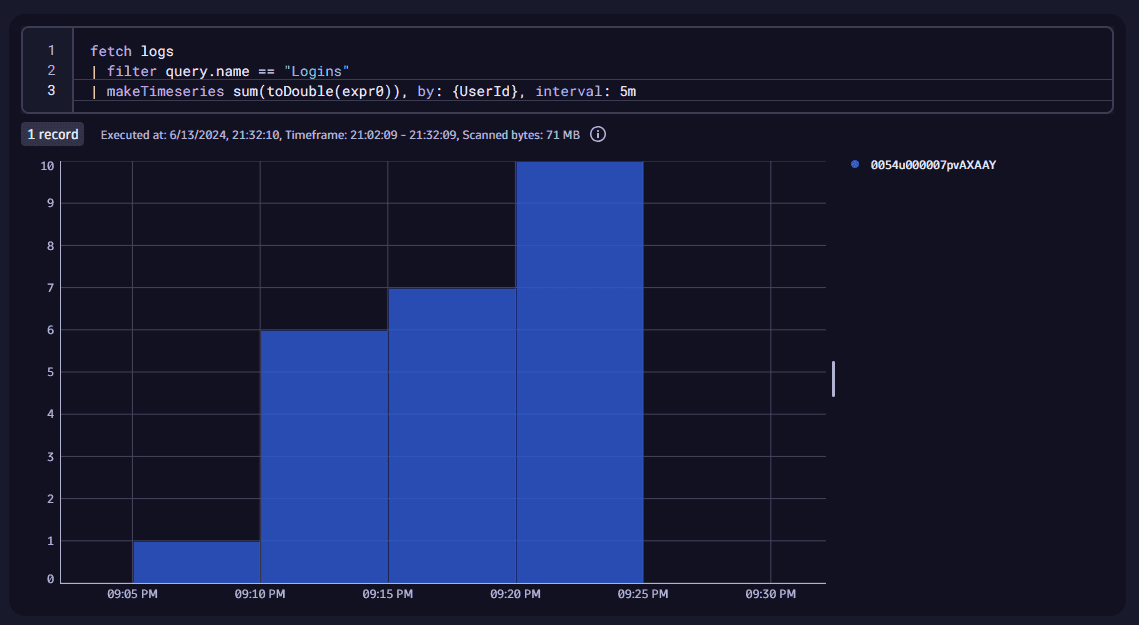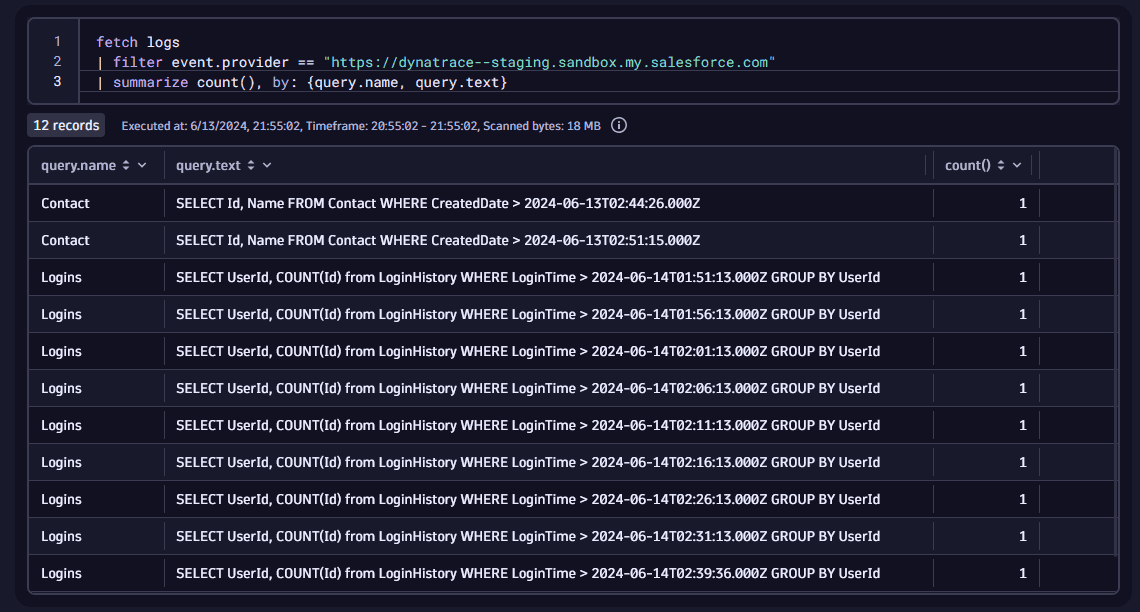Salesforce Insights
- Latest Dynatrace
- Extension
- 12-min read
Salesforce Insights enables Salesforce administrators and IT operation teams to monitor their Salesforce environment.
Setup
Learn how to set up Salesforce Insights and find out what kind of data it can capture.
Make sure to meet the following requirements to use the extension.
Salesforce account
The Salesforce extension can capture four types of Salesforce data. Select each configuration for more details.
-
The Event Streaming configuration allows you to monitor the usage of your Salesforce CRM account.
-
The EventLogFile configuration allows you to ingest log files from Salesforce into Dynatrace.
-
The API Queries configuration allows you to ingest Salesforce Object Query Language (SOQL) data into Dynatrace. The data is ingested into Dynatrace as log events or Business Events.
-
The Platform Events configuration allows you to subscribe to custom Salesforce Platform Events and ingest them as Business Events into Dynatrace.
Authentication
Choose one of the three authentication methods that best suits your needs.
In this mode the extension connects as a connected app. This is the recommended authentication mechanism.
Technically, the app implements the OAuth 2.0 JWT Bearer Flow.
Dynatrace will ask for
- The Consumer Key of the connected app.
- The Private Key of the connected app.
- The Subject of the JWT token—this is the username of a user that is part of a Profile in the connected app.
Requirements
-
openssl—for generating the certificate, not needed if you already have a certificate and a private keyNote: on Windows, if you have
gitinstalled, you should also have a copy ofopenssl.
You should find it in a directory such asC:\Program Files\Git\mingw64\bindepending on your installation.
Certificate
The connected app must have a certificate that we later authenticate with Salesforce using this certificate's private key.
This command generates a certificate and a private key:
openssl req -newkey rsa:2048 -nodes -keyout key.pem -x509 -days 365 -out cert.pem
- The
cert.pemfile will be later added to the connected app. - The
key.pemfile will be used by Dynatrace to authenticate with Salesforce.
Create the connected app
In Salesforce Lightning
- Under Setup > Apps > External Client Apps > Settings make sure that
Allow creation of connected appsis On. - Select New Connected App.
Name the app and add the contact email. Under API (Enable OAuth Settings):
- Check Enable OAuth Settings
- If the Callback URL is not used, you can put in
http://localhost - Check Use digital signatures
- Upload the
cert.pemfile generated above underUse digital signatures. - In Selected OAuth Scopes, add these scopes:
- Manage use data via APIs (API)
- Perform requests at any time (refresh_token, offline_access)
- Leave all other settings as default and select Save.
OAuth policy
- Set up the OAuth Policy permitted users.
- Under Apps > App Manager, Find the connected app and select Manage.
- Click the Edit Policies button.
- Under OAuth Policies select Admin approved users are pre-authorized.
- Select Save.
Approved users
Identify users that can use the app. You can do it by adding Profiles to the Application Profile Assignment list.
- On the connected app page, go to Profiles > Manage Profiles.
- Add profiles that can use the connected app. Note: Later, any username from these profiles can be used as the Subject when configuring the extension.
Profiles need the following permissions for event streaming:
- General user permissions
View Real-Time Event Monitoring Data
- Administrative permissions
Customize ApplicationView All Data
To check the needed permissions documentation, see how to Enable Access to Real-Time Event Monitoring.
Enable extension
To enable the Salesforce Extension, you must have an Environment ActiveGate.
- Find the extension in Hub and activate it.
- Select Add monitoring configuration on the Configuration page.
- Select an ActiveGate group.
- One of these servers will need to access the salesforce API, which is publicly available.
- The login URLs are:
https://login.salesforce.comorhttps://test.salesforce.com - The Pub/Sub endpoints are:
api.pubsub.salesforce.com:7443orapi.deu.pubsub.salesforce.com:7443 - A proxy can be configured later if necessary.
The parameters for the monitoring configuration
| Parameter | Description |
|---|---|
| Endpoint name | Choose a helpful name to identify the endpoint |
| Login URL | Choose from Production or Sandbox |
| Pub/Sub URL | Choose from Global Endpoint or Europe (Frankfurt) Endpoint |
| Reporting Mode | Business Events, Logs, OpenKit (RUM) |
| Custom Application ID | The Dynatrace Custom Application ID for the app you created before (only needed if a managed environment is used and OpenKit is used as reporting mode.) |
| Authentication type | Choose from username and password or connected app |
| Events filtering | Choose which real-time events you'd like to send to Dynatrace, by default all are enabled |
| Usernames Blocklist | Optional list of Usernames to ignore; use this to block automation/API users from reporting |
| Proxy | Optional proxy; in case the ActiveGate cannot connect to the Salesforce URLs |
If you use OpenKit, we recommend starting with the Custom Application setup.
Salesforce Data Ingest
Choose one of the three data ingest methods based on your monitoring needs.
Capture real-time events from Salesforce and send them as Business Events to Dynatrace.
RUM ingest should only be used on Managed Environments.
- Enable Real-time event Streaming.
- In Setup > Event Manager, enable Streaming Data for the events you want to capture.
- Obtain the credentials needed for the extension to connect to Salesforce.
Enable use cases such as:
- Track Session Hijack, Credential Stuffing and Anomaly Events
- Track important permission sets and changes
- What are the slowest Lightning or Classic pages response times?
- What files are being uploaded, downloaded, and by which user?
- What are the most used reports, who is running them, what queries are being used?
- What are the top API Queries being made?
- What browsers are users using?
- Where is Salesforce being accessed from?
- How many users are using the platform currently, what is the user experience?
The extension uses the Salesforce Pub/Sub API to list for Event Streaming Events. These events are captured and sent as Business events, or in case of OpenKit as User Actions, with all their respective properties sent as Action Properties.
For a detailed description of every event and their properties, see the Salesforce documentation.
Currently captured events
| Events | Description |
|---|---|
| ApiAnomalyEvent | Track anomalies in how users make API calls. |
| ApiEventStream | Track user API queries in your organization. |
| BulkApiResultEvent | Track when a user downloads the results of a Bulk API request. |
| ConcurLongRunApexErrEvent | Track when a Concurrent Long Running Apex error has occurred. |
| CredentialStuffingEvent | Track when a user successfully logs in to Salesforce during an identified credential stuffing attack. |
| FileEvent | Track file activity. For example, track when a user downloads or previews a file. |
| LightningUriEventStream | Track when a user creates, accesses, updates, or deletes a record in Salesforce Lightning. |
| ListViewEventStream | Track when a user accesses data with list views. |
| LoginAsEventStream | Track when an admin logs into your organization as another user. |
| LoginEventStream | Track when a user logs in to your organization. |
| LogoutEventStream | Track when a user logs out in the Salesforce UI. |
| PermissionSetEvent | Track when users are assigned the Modify All Data or View All Data permission through a permission set. |
| ReportAnomalyEvent | Track anomalies in how users run or export reports. |
| ReportEventStream | Track when a user accesses or exports data with reports. |
| SessionHijackingEvent | Track when an unauthorized user gains ownership of a Salesforce user’s session with a stolen session identifier. |
| UriEventStream | Track when a user creates, accesses, updates, or deletes a record in Salesforce Classic. |
The extension is limited to events that Salesforce produces as Real-Time Events.
Choose your reporting mode for Event Streaming data:
Business Events
For business events, all data is ingested using the business events API.
It can be queried using DQL:
fetch bizevents| filter event.type == "salesforce.ApiEventStream"
Visualization of a query result
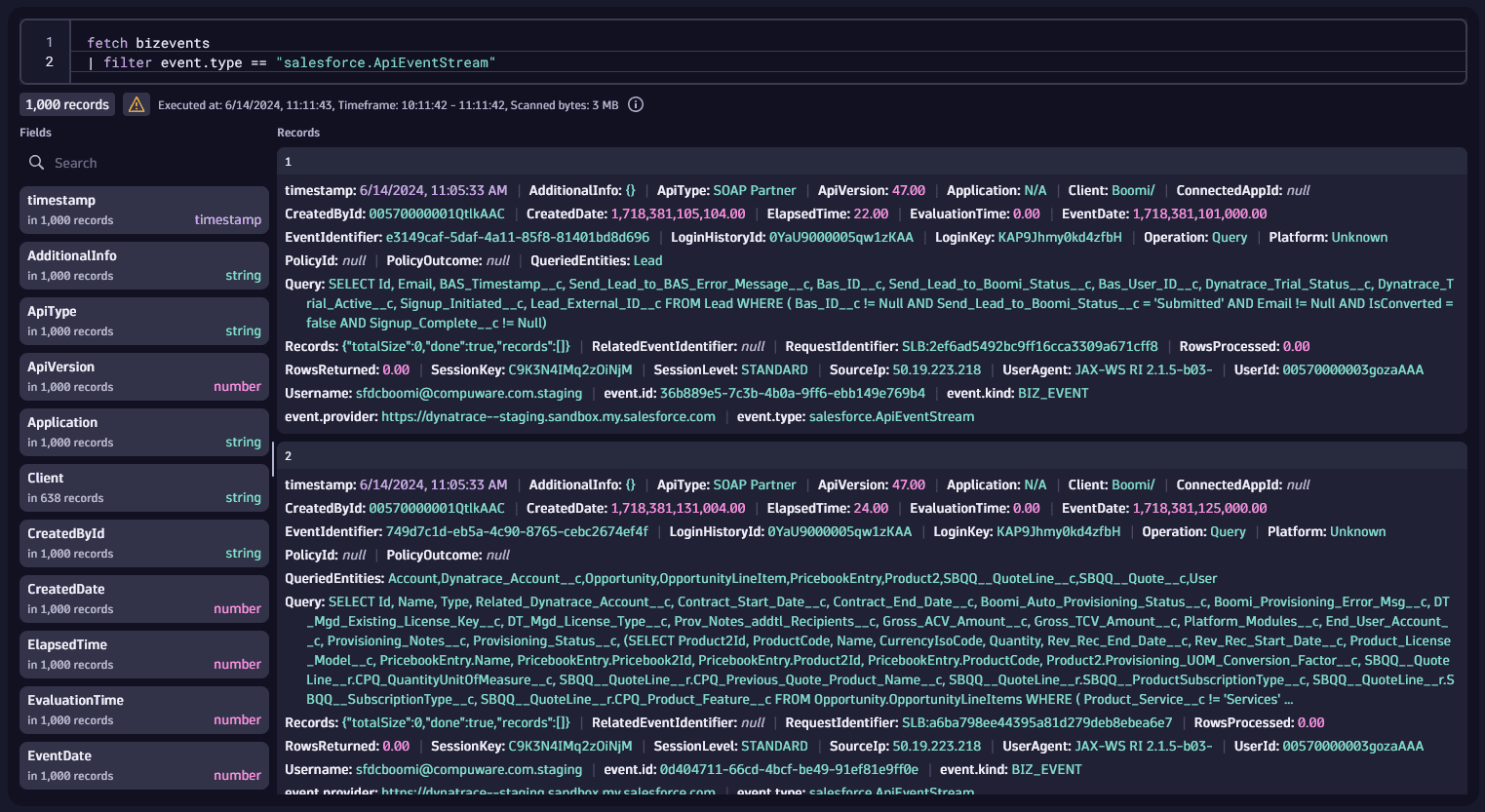
Each of the events of type salesforce.NameOfTheEvent will have all properties documented by Salesforce.
For instance, see the properties for an ApiEventStream.
So we can create visualizations using all of these properties.
fetch bizevents| filter event.type == "salesforce.ApiEventStream"| summarize count(), by: {SourceIp}
Visualization of a query result
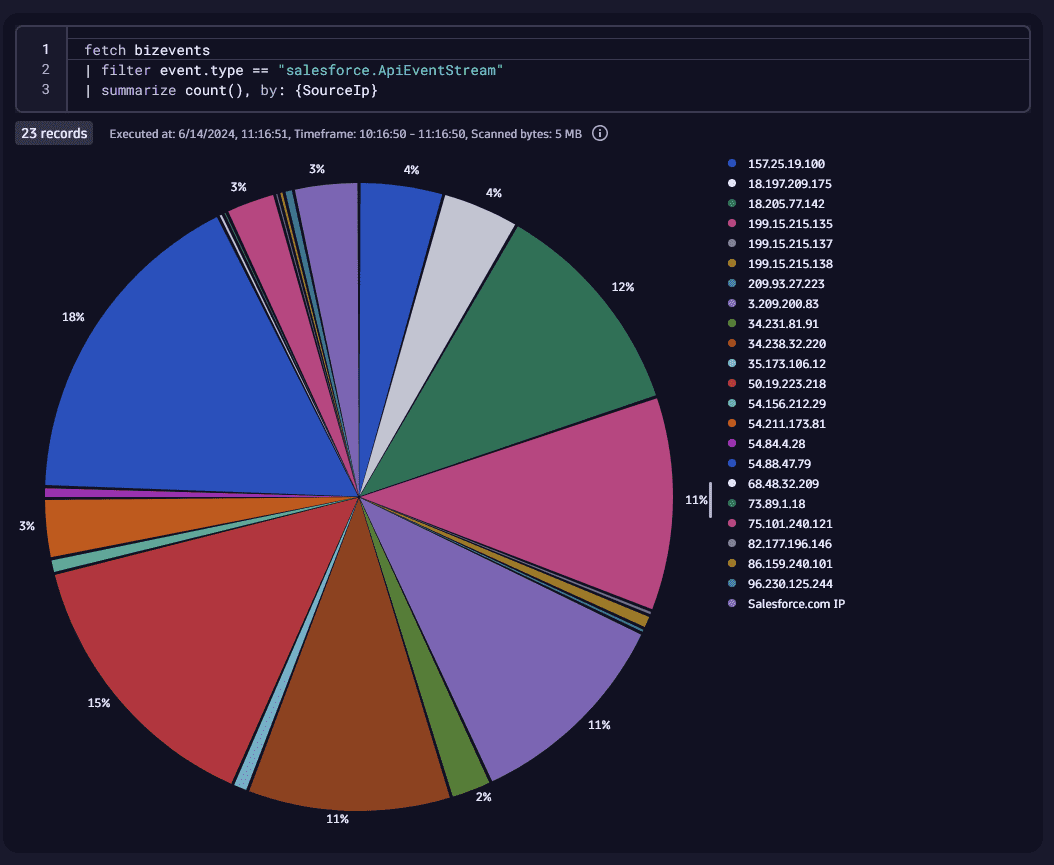
You can get a list of all event types with DQL:
fetch bizevents| filter event.provider == "https://dynatrace--staging.sandbox.my.salesforce.com"| summarize count(), by: {event.type}
Visualization of a query result

Example: Get logins by user overtime
fetch bizevents| filter event.type == "salesforce.LoginEventStream"| makeTimeseries logins=count(), by:{Username}, interval: 5m| sort logins desc
Visualization of a query result
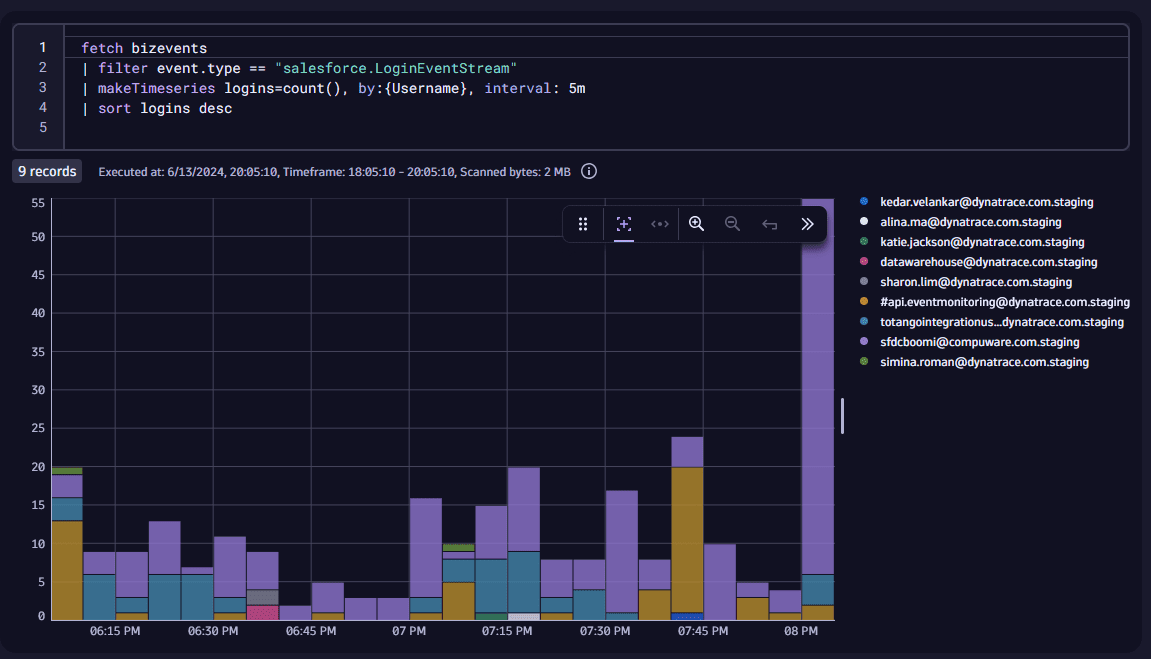
OpenKit
To create a custom application to receive the data:
- In Hub, see Digital Experience Monitoring section. Then, select Generic front end > Set up.
- Create your custom application—name it and choose an icon.
- Select Monitor custom application.
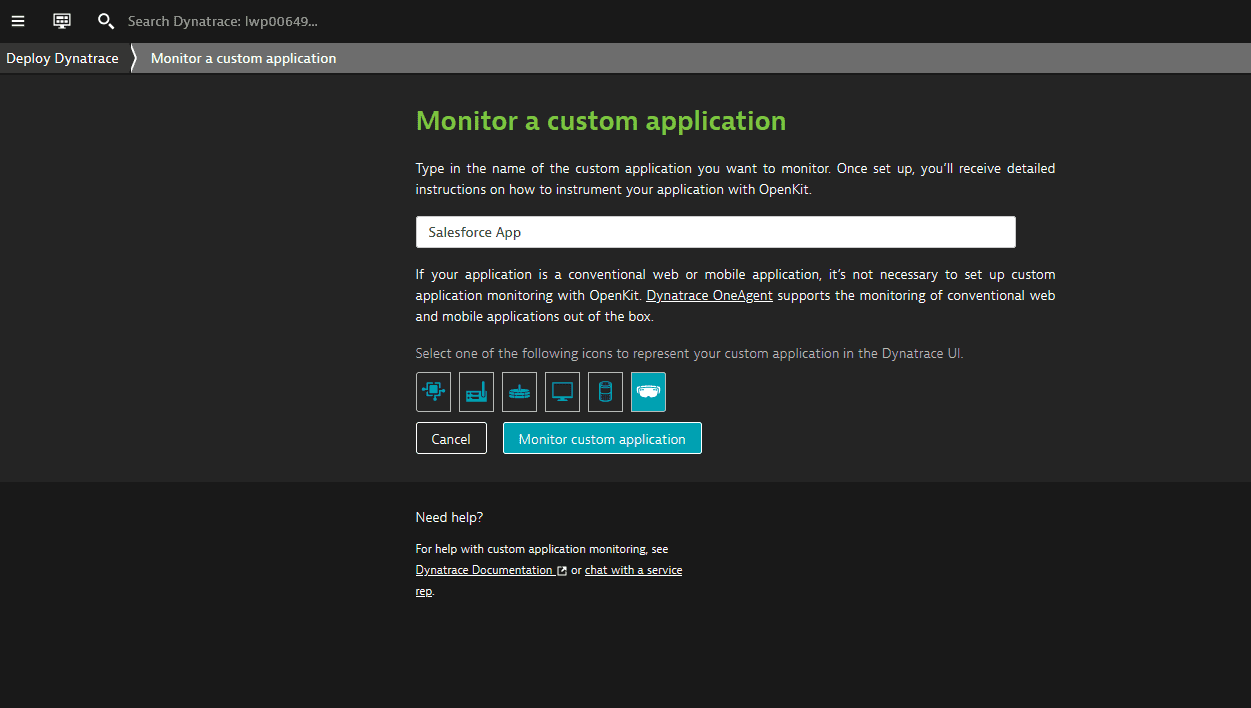
- In the Custom application settings, go to Instrumentation wizard and save the
Application IDfor later.
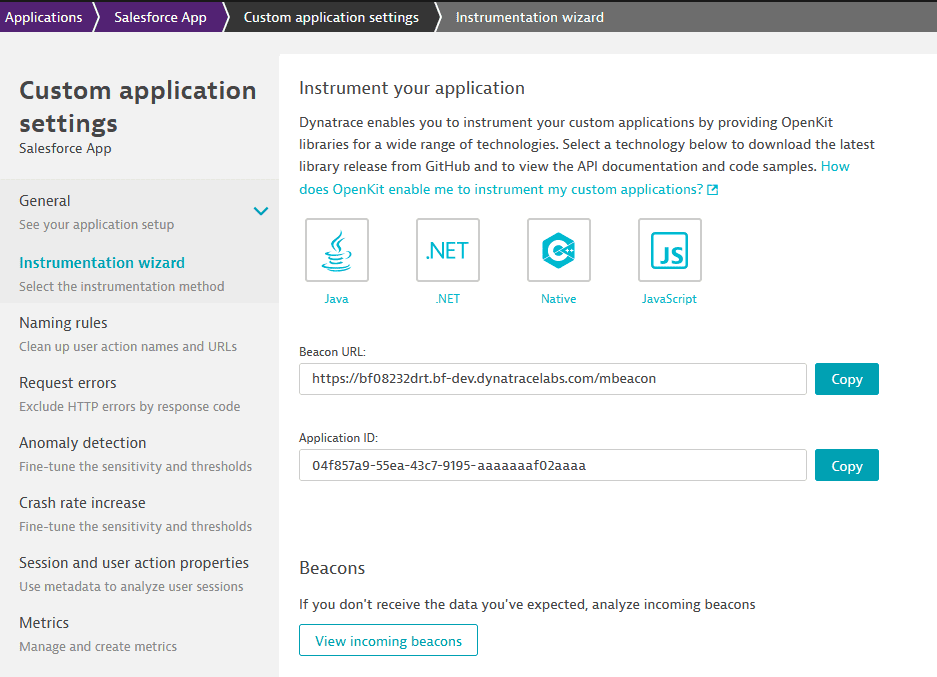
- Now you can enable the extension. For details, go back to the #enable-extension section.
The data is sent to the Frontend application that you created, so you can access:
- Sessions Details
- The individual properties, by selecting User Action > Perform waterfall analysis
To use these properties in User Sessions Query Language:
- In the application settings, go to Session and user action properties.
- Create a property. Note: the Name must match exactly the property name, see Salesforce events.
Example: Capture the rows number
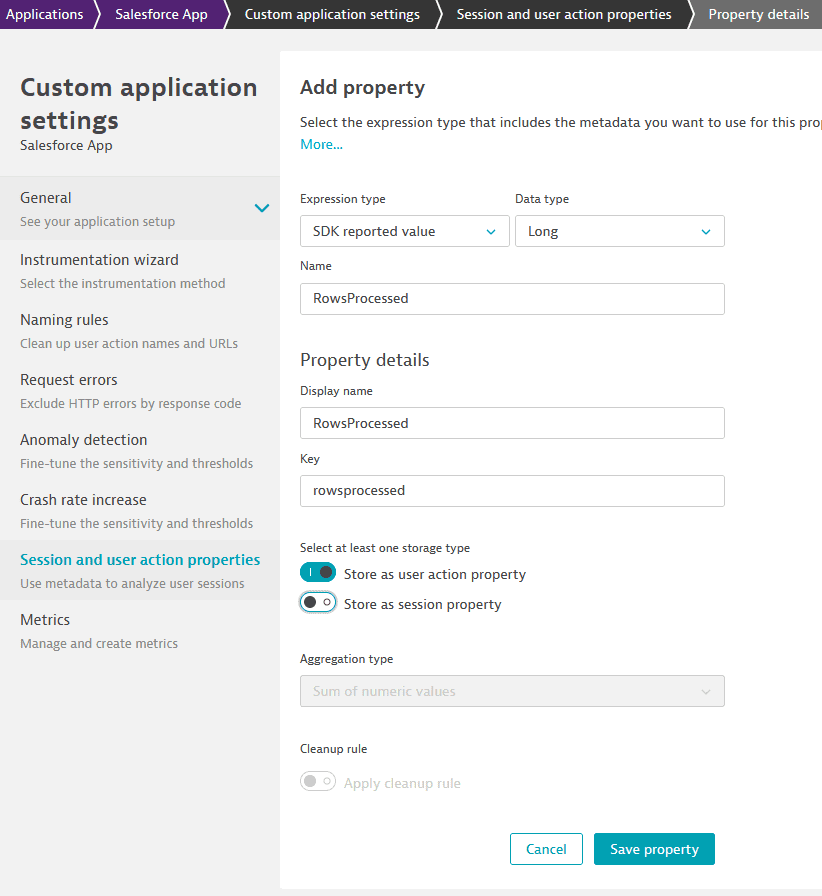
Querying the property:
SELECT useraction.name, SUM(longProperties.rowsprocessed) FROM useraction WHERE useraction.name STARTSWITH "Report" GROUP BY useraction.name
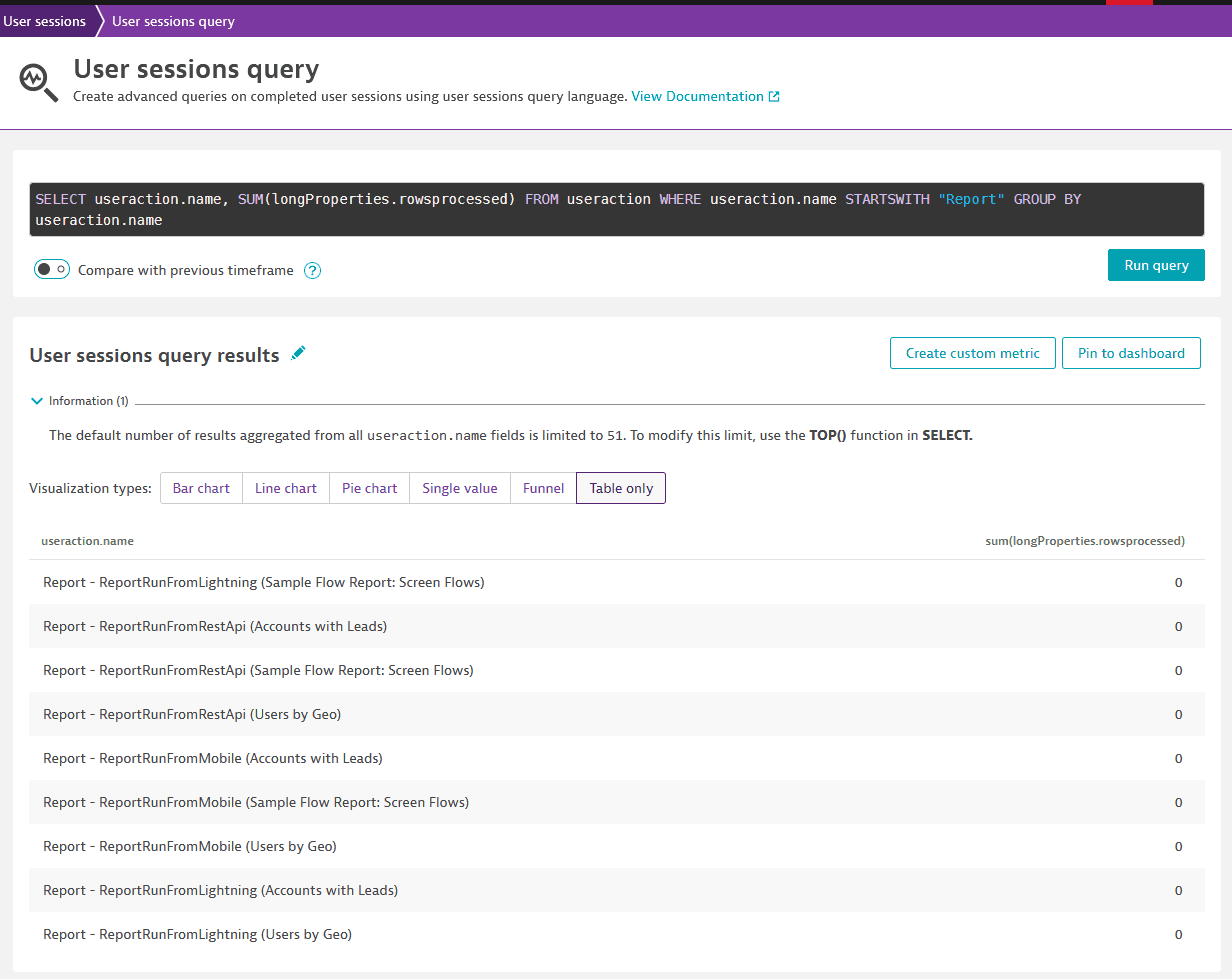
Extend the retention period for Salesforce Insights data
By default, your ingested data is stored for 30 days. You can adjust the retention time by creating a custom bucket.
To create a custom bucket for a Salesforce event
-
In Dynatrace, go to Settings > Business Observability > Bucket assignment.
-
On the Business event bucket assignment page, select Add rule and name your rule.
-
In the Bucket field, choose your retention period.
-
Add a Matcher to your rule by typing or pasting your matcher-specific DQL query. Events that match your rule will be assigned to your selected bucket. If no rules match, events will be assigned to the default bucket. To assign all your Salesforce events to your bucket, you need to use the matcher containing the
matchesValuefunction and your Salesforce URL, as in the example below.matchesValue(event.provider, "https://environment.my.salesforce.com") -
Select Save changes.
Troubleshooting
Error logs can be obtained via Dynatrace, by navigating to the Extension page, and selecting Status for each monitoring configuration.
Detailed logs can be obtained by creating an ActiveGate Diagnosis.
